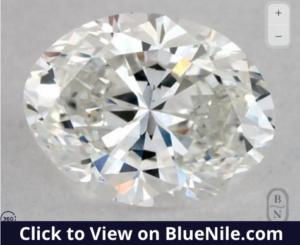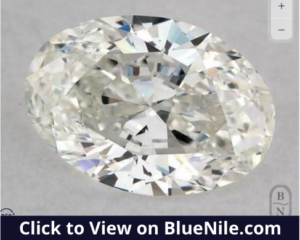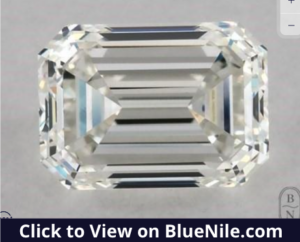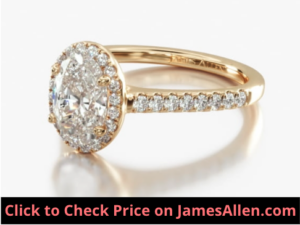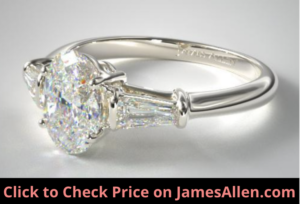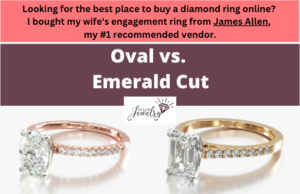
Oval and emerald cut diamonds are two popular choices for engagement rings. They offer an alternative to a traditional round cut while still displaying a sense of elegance.
The main difference between oval and emerald cut diamonds is oval cuts have brilliant facets, which result in stronger light performance. The step-cut facets on emerald cuts have a subdued glow. It’s elongated shape means it has a wider surface area than most cuts.
We’ll compare oval versus emerald cut diamonds across the most important areas to consider, such as:
- An overview of each
- Brilliance, fire, and scintillation
- Prices
- Settings
- And more
Let’s dive in.
What are Oval Cut Diamonds?
Oval cut diamonds are a combination of pear and round cuts. It has the round edges of a pear cut, but neither end comes to a sharp point.
Here’s an oval cut diamond from the vendor where I bought my wife’s engagement ring.
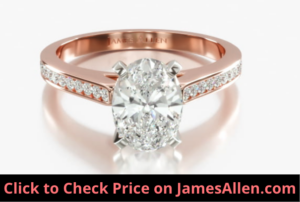
You can rotate the image 360 degrees on their site to learn how it appears at every angle.
Notice how all the edges are rounded. At a quick glance, you might mistake it for a round cut.
This modern cut is often designed with a length to width ratio of 1.30-1.45, which strikes a balance between distinguishing it from a round cut while also not cutting it too shallow.
Most have 57 or 58 facets.
You’ll often find them as the center diamond in an engagement ring, but they also serve as side stones that surround the main one. It’s rare to see oval cuts used as accents on the shank, with most jewelers preferring round, princess, or baguette diamonds in these positions.
What are Emerald Cuts?
Emerald cut diamonds have a rectangular shape and feature parallel facets that run across its table. Most include 57-step cut facets that resemble a set of stairs beginning in the middle and extending to its edges.
Take a look at this exceptional emerald cut engagement ring.
That style of facets is most evident when viewed from the top-down.
It’s known as a “hall of mirrors” effect.
Another distinct trait of emerald cuts are its four beveled corners. Along with its straight edges, there’s a total of eight sides. Four are the same length, and the other four also mimic each other.
The optimal length to width ratio is 1.4. Most on the market have a ratio of 1.3-1.5, and none of these measurements cause it to appear square. If you happen to find an emerald cut with a ratio between 1 and 1.05, it’ll resemble a square.
As a comparison, here’s a side-by-side of two emerald cuts, where the one on the left clearly has a higher length to width ratio than the one on the right.
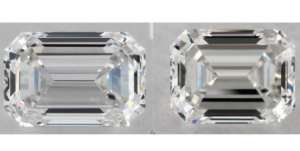
Emerald cuts are often compared to baguettes because of their rectangular shapes. The difference is baguette diamonds have squared-off corners for a total of four sides.
What are the Differences Between Oval and Emerald Cuts?
1. Brilliance, Fire and Scintillation
A diamond’s light performance is a combination of brilliance, fire, and scintillation. Brilliance is the white light, fire refers to colored flashes, and scintillation is the interplay between the two when a diamond is twirled.
Oval cut diamonds have superior sparkle compared to emerald cuts because of the way their facets are designed.
They mimic the triangular- or kite-shaped facets on a round cut that are developed to capture light, bounce it around inside the diamond, and return as much as possible to the viewer.
It minimizes how much is leaked through the bottom.
I’ve highlighted the triangular facets on this oval cut diamond.
Notice their small size, and how even in a high-resolution image, it’s difficult to distinguish between them.
While an oval cut’s brilliance, fire, and scintillation doesn’t match a round cut, you aren’t sacrificing too much glimmer.
This isn’t the case with emerald cuts. Their step-cut facets aren’t created to prioritize brilliance. Instead, it’s a subtle, warm glow that produces slow flashes of light.
For oval and emerald cuts, the best way to maximize light return is to choose a quality cut.
It’s the factor that most impacts how a diamond sparkles, even more than its clarity and color grade. So it’s worth the premium.
The Gemological Institute of America (GIA), which grades the qualities of diamonds, doesn’t provide a cut grade for fancy shapes like ovals and emeralds. Instead, you’ll have to rely on the specific measurements that make up cut grade, like polish, symmetry, and proportions.
2. Prices
Cut is one of the factors that affect the price of a diamond. Round cuts rank as the most expensive because it results in more waste of the original rough diamond, and there’s higher demand.
Cushion cuts are often the least expensive, and oval and radiant cuts fall in between.
I compared prices for oval and emerald diamonds from James Allen with the following qualities:
- Carat weight: 1.00
- Clarity: VS
- Color: I
The average price for an emerald cut with those grades was $3,832, with a range of $2,170-$4,610.
For oval cuts, the average was $4,581, with a range of $3,370-$5,050.
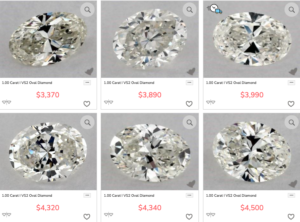
That’s a 20 percent premium for oval versus emerald cuts.
If you opt for an emerald cut, you could put those savings toward a larger carat weight or improved color, clarity, or cut grades.
3. Clarity Characteristics
The clarity grade of a diamond refers to the presence of inclusions and how they impact its durability, visible appearance, and light return.
In general, more inclusions diminish a diamond’s quality in these areas, but it depends on their type, size, and location.
Oval cuts often disguise inclusions to the naked eye more effectively than emerald cuts for two reasons.
The first is brilliant-cut facets display more white light, which hide minor instances of flaws like naturals, twinning wisps, and feathers.
Additionally, the large facets in emerald cuts leave inclusions exposed. You can more easily peer inside the diamond and spot blemishes.
So you may have to choose a higher clarity grade in order for it to appear flawless without magnification.
For most oval cut diamonds under one-and-a-half carats, you can begin your search with an SI diamond.
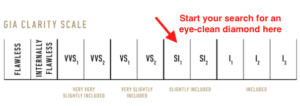
Always view it in person or through high-quality images so you know whether inclusion are noticeable.
As an example, this 0.90-carat oval cut earned an SI1 clarity grade.
You can view minuscule black specks in the image on the site, but I wouldn’t expect them to be visible without magnification.
For emerald cuts, you may have to start with a VS2 clarity grade.
Check out this emerald cut, which earned that mark.
Here’s the clarity characteristics plot on the GIA report.
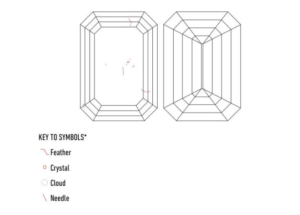
It notes the presence of:
- Feathers
- Crystals
- Clouds
- Needles
But even with the close-up view, they’re difficult to identify.
You’ll pay a higher price for VS2 clarity compared to one in the SI range, but the cost is balanced out by emerald cuts selling for a lower price.
4. Color
Colorless diamonds are more valuable than ones that show yellow or brown tints. At one end of the color scale are D, E, and F, which are colorless.
The other end of the spectrum holds S-Z diamonds.
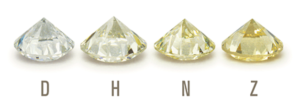
For similar reasons to clarity, oval cut diamonds hide color more than emerald cuts. The strong brilliance from oval cuts overcomes light yellow shades, so it appears colorless even at some lower grades.
Large, deep facets in emerald cuts can’t do the same and instead retain color.
Start your search for an emerald cut with H color grades. You’ll avoid the premiums of a colorless diamond, but it may still appear that way to the naked eye.
For oval cuts, there are ones with I color grades that disguise the yellow.
For example, this diamond received an I color grade from the Gemological Institute of America.
Although that falls into the “near colorless” category of the GIA scale, you can’t see that color, even in the high-resolution image.
As a comparison, this I-color, 0.90-carat emerald cut starts to show yellow around its edges.
By moving up one color grade to H, that yellow will start to disappear.
5. Size in Relation to Carat Weight
The primary way to measure the size of a diamond is its weight. One carat equals 0.2 grams.
So a one-carat oval cut and a one-carat emerald cut are considered the same size.
But certain cuts look larger or smaller to the naked eye depending on their shape. They could also have different lengths and widths, which are measured in millimeters.
Oval and emerald cuts appear larger than most other shapes like Asscher and radiants.
They both earn that status because of the elongated, stretched shape. If you placed each of them next to a round or princess cut of the same carat weight, you’d likely think they were heavier.
This allows you to buy a lower carat weight while still retaining the size of these other cuts.
It’s an effective way to save on the cost of your ring because there are disproportionate price increases as you move to higher carat weights.
For example, you’ll pay more than twice as much for a one-carat diamond as a 0.5-carat diamond.
6. Styles of Settings
Oval and emerald cuts fit a variety of settings.
I personally chose a four-prong solitaire setting for my wife’s engagement ring, which is one of the most popular styles for both cuts.
But I recommend to my readers they explore alternative styles as well to enhance the aesthetic of the piece.
As examples, options for oval cuts also include:
- Tension
- Sidestone
- Halo
- Three-stone
This oval cut engagement ring is placed in a halo setting with diamond accents lining the shank.
It creates the illusion of a larger diamond because it blends together with the halo.
This setting features tapered baguette diamonds surrounding the oval cut.
Notice how the baguette diamonds are distinguished from the main gem instead of blending in like the halo.
Many of the same options are available for emerald cuts, but there are also unique variations.
These examples demonstrate there are many styles that complement emerald and oval cuts, so you don’t have to choose a simple four-prong, solitaire setting.
7. Popularity
Oval and emerald cuts are equally popular as the center diamonds in engagement rings. Industry estimates place both around three percent of diamond sales.
Another way to measure the popularity of diamond cuts is exploring the inventories of popular vendors.
To illustrate, I filtered for oval cuts on James Allen’s website to include all carat weights and color, cut, and clarity grades.
There were 30,500 available.
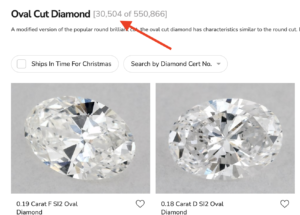
For emerald cuts, there were 36,000 in their inventory.
When I did the same for round cuts, they showcased more than 362,000 diamonds.
It’s clear there is more demand for round cuts than emerald or oval.
You’ll notice this same pattern if you walk into any brick and mortar jewelry store, like Zales or Jared. There are far more round diamonds than fancy shapes.
It’s another reason to consider an online vendor with a larger selection.
Is an Oval or Emerald Cut Right for You?
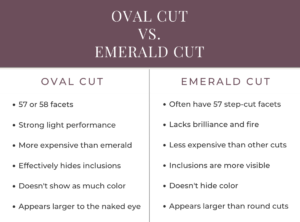
Deciding on an oval versus emerald cut diamond involves knowing the traits that determine their overall performance as the center diamond on a ring.
Here are some guidelines to help you learn which is right for you.
Consider an oval cut if:
- You want a diamond that has many qualities in common with round cuts but costs less per carat
- You’re interested in an alternative to the most popular cuts but don’t want to sacrifice brilliance
- Its overall shape is appealing, and you want a diamond that effectively hides small flaws and tints of yellow
Choose an emerald cut if:
- You aren’t interested in a diamond with strong light performance but are instead satisfied with its warm glow
- You’re looking for a cut with one of the lowest costs per carat
- You want a rectangular diamond with large facets
By comparing oval and emerald cuts, and pairing them with multiple styles of settings, you can create the perfect diamond ring for you.

Jacob Clarke
Jacob Clarke is the founder of TeachJewelry.com.
He earned an Applied Jewelry Professional Diploma from the Gemological Institute of America (GIA) and now brings you essential information about diamonds, settings, and more.
Jacob has consulted with leading jewelry brands, and his work has been cited in Clean Origin, Diamond Nexus and industry publications.
He's also a member of the International Gem Society.
He enjoys discussing jewelry with readers, so contact him with any questions at jacob.clarke@teachjewelry.com.


